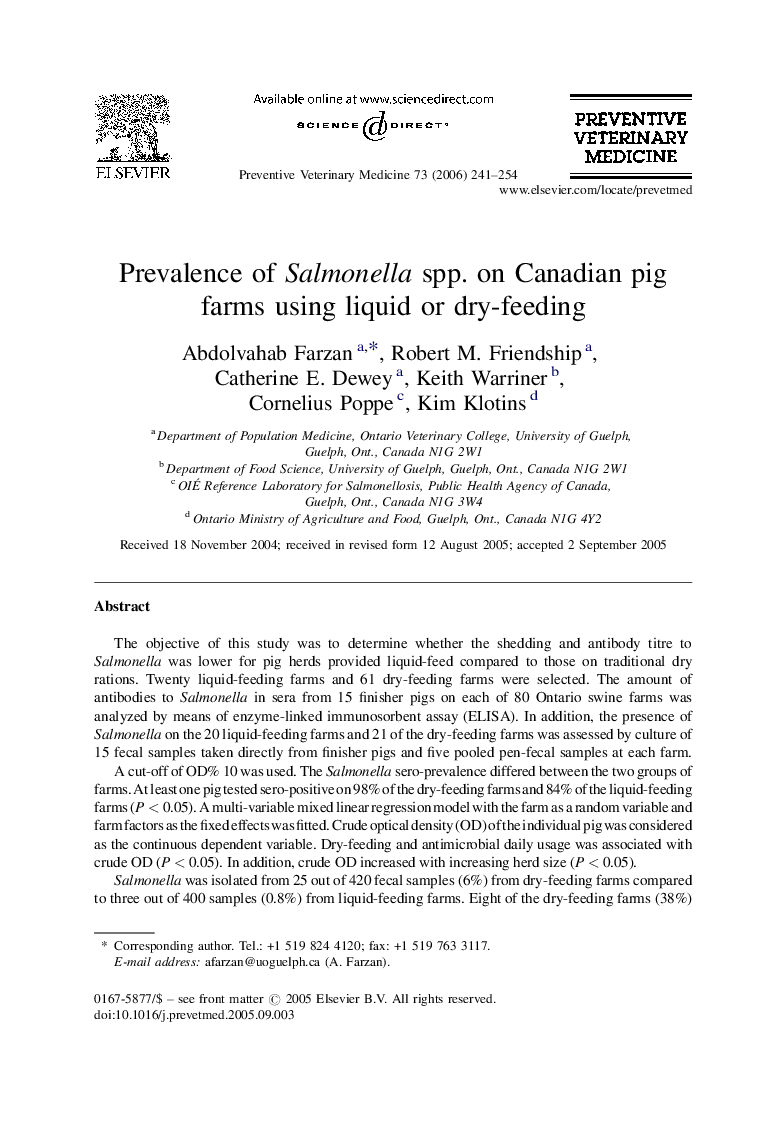| کد مقاله | کد نشریه | سال انتشار | مقاله انگلیسی | نسخه تمام متن |
|---|---|---|---|---|
| 2453649 | 1110114 | 2006 | 14 صفحه PDF | دانلود رایگان |

The objective of this study was to determine whether the shedding and antibody titre to Salmonella was lower for pig herds provided liquid-feed compared to those on traditional dry rations. Twenty liquid-feeding farms and 61 dry-feeding farms were selected. The amount of antibodies to Salmonella in sera from 15 finisher pigs on each of 80 Ontario swine farms was analyzed by means of enzyme-linked immunosorbent assay (ELISA). In addition, the presence of Salmonella on the 20 liquid-feeding farms and 21 of the dry-feeding farms was assessed by culture of 15 fecal samples taken directly from finisher pigs and five pooled pen-fecal samples at each farm.A cut-off of OD% 10 was used. The Salmonella sero-prevalence differed between the two groups of farms. At least one pig tested sero-positive on 98% of the dry-feeding farms and 84% of the liquid-feeding farms (P < 0.05). A multi-variable mixed linear regression model with the farm as a random variable and farm factors as the fixed effects was fitted. Crude optical density (OD) of the individual pig was considered as the continuous dependent variable. Dry-feeding and antimicrobial daily usage was associated with crude OD (P < 0.05). In addition, crude OD increased with increasing herd size (P < 0.05).Salmonella was isolated from 25 out of 420 fecal samples (6%) from dry-feeding farms compared to three out of 400 samples (0.8%) from liquid-feeding farms. Eight of the dry-feeding farms (38%) tested positive compared to only three of the liquid-feeding farms (15%). Salmonella was also recovered from the pen environment on five dry-feeding farms but were not isolated from the facilities using liquid-feeding. Salmonella Typhimurium was isolated from four farms in the dry-feed group and on one farm with liquid-feeding. The one S. Typhimurium isolate from the liquid-feeding farm exhibited no antimicrobial resistance, but those from dry-feeding farms were resistant to four or more antimicrobial agents. The results of the logistic regression, with farm as a random effect showed that dry-feeding [OR = 2.7 (1.1–15.1)] and continuous flow system [OR = 2.3 (1.2–12.7)] increased risk of finding Salmonella in the individual pig.These findings indicate that liquid-feeding and all-in all-out management of the grower–finisher barns can reduce the Salmonella prevalence.
Journal: Preventive Veterinary Medicine - Volume 73, Issue 4, 16 March 2006, Pages 241–254